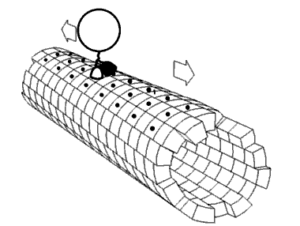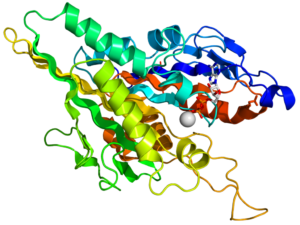Molecular Biology Confirms Intelligent Design
The increasing complexity of life discovered by molecular biology confirms intelligent design theory.
Molecular biology came of age in the 1990s with the development of new investigation tools. These tools for the first time in human history allowed the investigation of the inner workings of cells. Advances in molecular biology confirm intelligent design theories rather than natural origins.
It has been the hope of research scientists and their funding agencies that these new tools will enable new advances. The informed treatment of cancer and other genetic diseases becomes possible.
The past thirty years has seen an explosion of knowledge about how cells work. We now have an understanding of some of the molecular processes that keep cell alive.
Volumes of hundreds of various research journals are written each year concerning these discoveries. One thing has become apparent: there is no end in sight in understanding this complexity.
Life becomes progressively more complex the most scientists investigate its complexity. There seems to be no end in sight to this progressive complexity.
The simple molecular pathways that adorn every biochemistry book are now tremendously outdated.
Molecular biology now has tremendous theological implications we shall now explore.
In The Beginning …
Biologist of the nineteenth century were not impressed with the complexity of cells. Part of this lack of appreciation was due to their ignorance of how the cell works. This was still a century before the discovery of DNA, and how proteins work to make cell metabolism possible.
Scientists thought a bacterial cell was a thin membrane wrapped around “protoplasm.” This material was a “jelly-like substance” that was the fundamental structure of life.
Over the next 150 years, scientists have come to understand some of the vast complexity of life. We now know of thousands of pathways, amplification and dampening loops, motors, tubules, vesicles, transfer factors, modulins and so on. These pathways fill tomes of journals every year.
An example – Kinesin
The kinesin system is one such recently discovered pathway for keeping certain cells functional.
Kinesin consists of two heavy chains and two light chains. The heavy chain is considered medium length at about 1000 amino acids long. Heavy chains and light chains are attached to each other.
The heavy chains have two parts – one part is made to utilize a high energy phosphate called adenosine triphosphate or ATP. ATP provides energy for the whole process to work.
The heavy chain binds and releases from another protein called tubulin. Tubulin forms microtubules forming a skeleton structure of each cell. The kinesin molecule releases and attaches to the tubulin structure allowing it to march down the tube.
The light chains are attached to the other half of the heavy chain, along with various cellular baggage attach. The whole process is to carry this baggage to the far end of long cells keeping them alive.

Kinesin walking along microtubules – 1000 times a second.
Some of the longest cells in the human body use this mechanism. For example, the sciatic nerve stretches from the lower back to the tip of your toes. These long cells require the baggage carried by the kinesin molecules.
Implications
The cartoon above shows the “walking” ability of kinesin along tubular structures to enable delivery of baggage. This walking requires the interaction of multiple proteins as well as other molecules.
The kinesin system is only one of many thousands of similar systems all operating all the time in each of our cells. These systems keep us alive, and are vital for our health.
So, how did this all come about?
Biologists, for the most part, are still married to a naturalist philosophy – at least in public. Few of them are willing to accept the implications of the increasing complexity of living things.
“Self-Engineering” Principle
Some have asserted a self-engineering capability of life. This would be some nebulous, poorly understood ability of life to increase the complexity of molecular pathways.
Of course, such a mechanism is pure speculation and has never been demonstrated. There is good reason to believe that such self-engineering may not be possible.
The usual explanation given is organisms develop kinesin under environmental stresses and natural selection. But conservation of information theory suggests such a mechanism is impossible.
Another reason a self-engineering or self-organizational principle seems unlikely is the progress of knowledge. Over time, these systems have been getting progressively more complicated by an exponential factor.
This means it is likely that a decade or two from now we will understand more of the system. But it is also likely that the systems we do know will also become more complex the more we know.
Nanoengineering
The progress of science suggests life is a process of intelligent nanoengineering. The extraordinary complexity of life is simply not obtainable by blind chance and natural selection.
Ongoing experiments suggest the vast amounts of information required for life at all, let along for intelligent life, simply cannot be obtained this way.
Advances in the understanding of antibiotic resistance, for example, help make this case. Usually, these changes render the bacterium less functional in usual environments. Resistance usually is due to loss of information – such as a binding site used by the antibiotic.
Conclusion – Molecular Biology Confirms Intelligent Design Theories
The progress of information over the past century has been phenomenal. We now understand cellular processes much better than we did even ten years ago.
As related previously, the best scientists of 150 years ago had an almost child-like understanding of molecular biology. They had no concept of metabolic pathways, genetics, DNA, protein three-dimensional structure, etc.
With further knowledge came the realization of the progressive complexity of life. Further investigation reveals life becomes more complicated. It is rather like peeling back layers on an onion; one layer pulled back reveals yet another layer of complexity.
This is likely why the once heralded potential ability to make life in the laboratory has never been realized. Even the best and most sophisticated molecular biology labs are unable to make life. Not even the simplest bacteria is within their reach.
The unfolding complexity of life is certainly with the understanding of intelligent design advocates. They propose life was purposefully engineered by an intelligent designer and not by blind natural processes.
It seems ludicrous to suppose life could spontaneously arise in a hostile earth environment by chance. This is even more laughable considering our best and brightest scientists and laboratories are unable to engineer even a simple bacterium. As time passes, it becomes clearer molecular biology confirms the intelligent design theory.





